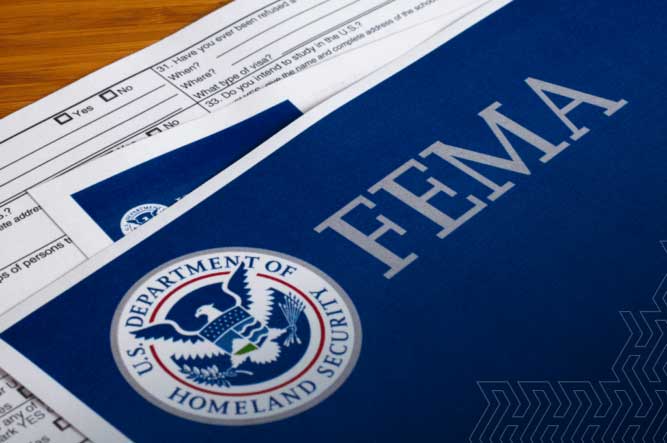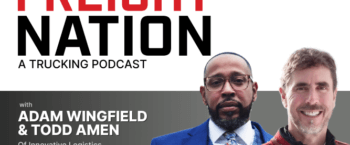Emergency Freight: Understanding FEMA Loads for Truckers

What are you waiting for?
Make more money starting now.
If you are hauling for FEMA (Federal Emergency Management Agency) or planning to do so, it’s critical to understand the significance of these loads and the role of truckers in transporting them.
In a time when people are leaving an area ahead of or as a result of natural disasters like hurricanes, earthquakes, or tornadoes, trucking companies are tasked with moving necessary and essential relief supplies to the area quickly.
While many truckers feel called to help in these situations, disaster relief efforts present different circumstances and expectations for drivers.
We have compiled a guide to help you better understand what you can expect when hauling FEMA truck loads and how to find FEMA loads.
What Are FEMA Loads
A FEMA load is cargo containing essential supplies, delivered to regions predicted or already experiencing natural disasters.
There are different types of FEMA loads including:
- Search and rescue equipment. Often the first loads sent in, search and rescue items help trained professionals assist as many people as possible—quickly.
- Emergency food supplies. This includes food with a long shelf life. Canned goods, dry mixes, and other staples items to feed families.
- Drinking water and water purification systems. Often water systems are down for days or even weeks after a disaster. Having clean drinking water is essential.
- Medical equipment and supplies. Hospitals are frequently damaged or overloaded with patients during a natural disaster. Getting medicine and medical supplies delivered can be critical.
- Construction materials. To facilitate rapid repair and restoration efforts, construction materials like lumber and supplies are needed.
- Power generators and fuel. When power systems are damaged and unavailable, generators are needed to restore an area. Fuel is also necessary to power trucks and other equipment in an area.
- Disaster cleanup supplies. The amount of debris is often staggering after a natural disaster and having proper tools to clean up helps everyone involved.
- Clothing and personal care items. People often can’t access their personal belongings during a natural disaster. Clothing and personal care items can help until they can return home.
- Communication equipment. These items allow first responders to continue their efforts efficiently. Communication devices also let people notify loved ones of their whereabouts to get help faster.
The Challenges of Hauling FEMA Loads
Hauling FEMA loads is different from any load you might haul on a regular basis. They come with their own specific challenges, and it’s important to be prepared for them.
Here are some you might face when hauling a FEMA load:
- Unpredictable schedules and last-minute changes. Disaster brings unpredictability. Be flexible and prepared to help in different capacities.
- Dealing with disaster-stricken areas and potential safety risks. Entering a natural disaster area can present unsafe roads, infrastructure, or weather conditions. Come prepared with necessities in case you are confined to your truck. and prepare to take care of yourself as much as possible.
- Long waiting times at loading and unloading sites. It’s important to be patient while relief coordinators are working to plan the best way to assist those affected. Expect some disorganization due to unforeseen circumstances and be accommodating to changes or long wait times.
- Increased scrutiny due to government regulations. Hauling for FEMA means you are hauling for the government. With this comes additional regulations and paperwork.
- Need for specialized equipment or handling procedures. Because of the damage done to the area, it’s likely specialized equipment or handling procedures will be required. Be patient and open to asking for help if you need it.
- Stress and emotional toll due to disaster situations. You will likely see extreme situations which can take a toll on your mental health. Remember why you are there and take time to decompress when you can.
- Communication difficulties due to disrupted networks. When cell phone towers are down and power lines are likely to be disrupted, having a backup plan, such as written directions and contact information on paper, is essential.
- Unexpected weather conditions and hazardous road conditions. Expect roads to be damaged, trees to be on the road, and unexpected weather conditions like flooding. Be prepared to keep yourself safe as you navigate these conditions.
Ways You Can Prepare to Help
Generally, if you’ve committed to hauling FEMA loads there are steps you can take to prepare yourself and your vehicle.
- Regularly maintain and inspect your vehicle. Do regular maintenance and thorough inspections of your vehicle and your equipment so you don’t encounter your own unexpected disasters.
- Invest in a good GPS system and keep updated road maps. Apps on your phone can be unreliable if communication systems and cell towers are down. Make sure you have truck routing software or an updated atlas in case of emergency.
- Equip your truck with emergency and survival equipment. Check your vehicle and be sure you have everything you need in case you find yourself living in your truck for a few days.
- Understand and comply with all government regulations. With government contracts come more specific guidelines. Be sure you understand all government regulations before you begin your journey.
- Stay informed about weather conditions and potential hazards. Be prepared to drive in extreme weather. Check the forecast regularly for changing conditions.
- Keep communication lines open and check in regularly. Dispatchers are your friend, and be sure and check in with them regularly.
- Practice patience and stress management techniques. Be prepared for chaos at staging areas. You will be dealing with government officials who are managing constant change and working tirelessly to keep systems moving. Instructions may change often.
- Ensure adequate rest and self-care while on the road. Take care of yourself. You might be tempted to work more than you should and jump in to help with disaster relief, but remember a drowsy driver is an unsafe driver.
- Keep your paperwork organized and readily available. Keep your paperwork where you can get to it easily and in a waterproof bag. This should include compliance documents like proof of insurance, FEMA eligibility, MCA, CDL, truck and trailer registration, etc.
- Take part in disaster response training, if available. Being prepared personally for what to do in case of a disaster is important for your confidence when hauling a FEMA load. It can also keep you and those around you safe.
How to Become a FEMA-Approved Driver
To be approved to haul FEMA loads, you must go through an application process and stay compliant with all regulations.
Here are a few tips on how to get started:
- Read FEMA’s Instructions for All Potential Transportation Service Providers including important dates like application registration deadlines.
- Get approval. You’ll need to read three different guides:
- FEMA Standard Tender of Service
- FEMA Uniform Rules Tariff No. 400
- S. Government Freight Transportation Handbook
- Visit SAM.gov to be sure your registration is approved, current, and active.
- Prepare your compliance documents, including insurance and proof of eligibility.
- Fill out the TSP Registration form and request an account with Logistics Supply Chain Management System Cloud
- Receive official approval email
- Once you’re approved, follow the Standard Tender of Service (STOS) Program.
How to Find FEMA Loads
If you’re ready to haul another FEMA load, here are some ways you can find them:
- Utilize load boards for FEMA loads. Check out load boards like Truckstop emergency freight loads. Be sure to read the load notes and confirm with a broker for details.
- Network with other truckers who have experience hauling FEMA loads. Work with your carriers and owner-operators to find more FEMA loads.
- Keep up-to-date with FEMA announcements and disaster relief efforts. Follow FEMA’s announcements and keep up to date with what’s going on in your area.
- Attend industry events and forums where FEMA contracts are often discussed.
- Build a strong relationship with FEMA-approved brokers.
- Regularly check FEMA’s official website for load opportunities.
- Follow social media accounts and blogs related to trucking and FEMA loads.
- Collaborate with transportation companies already involved with FEMA operations.
- Maintain a good reputation and high service levels for potential direct contracts with FEMA. Comply with all trucking regulations and keep your driving record clean.
Trucker Are Essential for Emergency Freight
Trucking is vital for disaster relief in the United States. Without enough drivers, delivering essential goods to disaster-affected areas becomes impossible. No matter what the natural disaster is, the trucking industry finds solutions to keep the country’s supply chain moving and provide emergency freight where it’s needed most.
Mobilize Your Operations with Truckstop Go
To get all the load board information you need in the palm of your hands, download Truckstop Go and find high-paying loads, negotiate the best rates, and keep your truck moving.
Download Truckstop Go to get started.

Find out how our platform gives you the visibility you need to get more done.
Get helpful content delivered to your inbox.
Schedule a demo.
Find out how our platform gives you the visibility you need to get more done.





